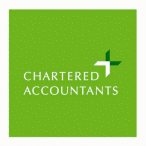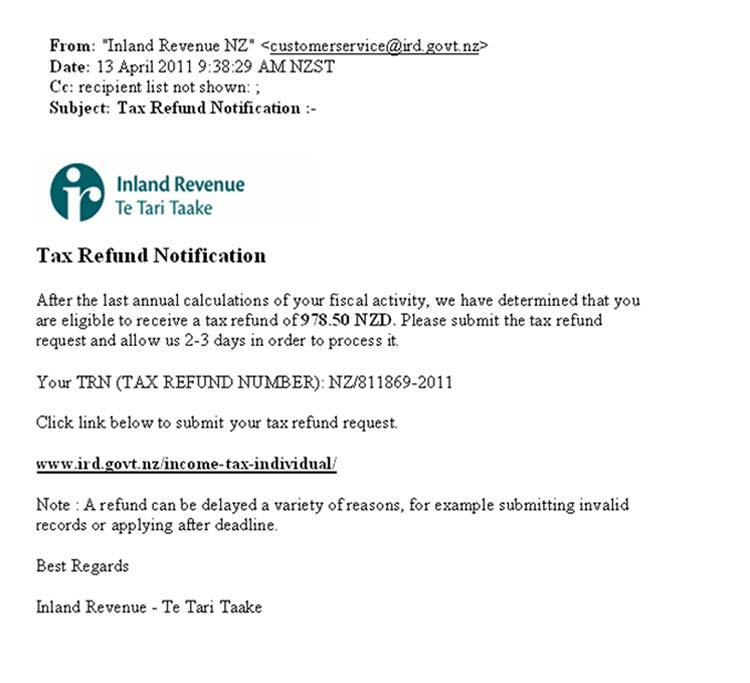-
All text must be copied without modification and all pages must be included.
-
This document must not be distributed for profit.
McLEAN
AND CO.

NEW CLIENTS
Warnings about Scam Emails purporting to be from Inland Revenue Department
The Profit and Loss Statement
Drivers of Profit and Cashflow
The minimum wage will increase from the current $13 per hour to $13.50 an hour, the Government had announced. The training and new entrant minimum wage will increase from $10.40 to $10.80.
This comes into effect on April 1, 2012.
Be ultra careful about giving out your IRD number and any other personal details to email callers.
Emails can circulate which attempt to trick recipients into divulging personal information. These emails are known as phishing emails. For example, an email may claim to come from Inland Revenue or a Tax Refund Agency asking you to click on a link that takes you to a fake website.
Do not click a link, or reply to an email, fitting this description. Inland Revenue will not send you a hyperlink in an email. Delete the email from your Inbox and Trash folders.
The following is an example of a scam email which McLean and Co, and we are aware a number of clients have received also:

THE PROFIT AND LOSS STATEMENT
The Profit and Loss statement (or statement of financial performance) provides a picture of your business trading performance over the last accounting period - usually a year, and generally from April 1st of one year to March 31st of the year after. It records sales, costs and expenses, profits (or losses), and any tax payments for the period. This is the document that Inland Revenue uses to determine what tax you owe, so it is important that you understand how it works.
The Profit and Loss statement usually follows this relatively easy format:
Turnover (or sales).
Less: cost of sales (your 'direct' costs, such as raw materials).
Equals gross profit (turnover less cost of sales).
Less: fixed or 'indirect' costs (also called business overheads) such as rent, rates and salaries. This will include depreciation on fixed assets.
Equals operating profit or net profit before tax.
Less: tax payable.
Equals net profit after taxation
The Profit and Loss statement is usually straightforward and relatively easy for non-financial managers to understand., but you might need to ask questions about some elements of the statement to understand all the information in it.
Some things aren't included. For example, the principal repayment of a loan is not included in the Profit and Loss statement, because it does not count as an expense, in the same way that injecting additional capital doesn't count as sales. But the interest you pay on a loan is an expense that you would include.
As a business owner, you'll want to claim as many legitimate expenses as possible to keep the tax bill down; however, it is important not to rush out and buy things you don't really need just to reduce your tax bill. You'd be better off making a higher profit and paying a little extra tax, than a lower profit and spending your hard earned cash on things you don't need.
The best use of your profit and loss statement is to look at your profit margins, and to see if any expenses have increased dramatically since last year.
Gross profit: Your gross profit margin is your gross profit as a percentage of turnover. For example, if your turnover is $2mn with a cost of sales of $600,000, you have a gross profit of $1,400,000 and a gross profit margin of 70% (1,400,000 ÷ 2,000,000 x 100). So every $100 of sales generates $70 that goes towards paying for expenses (and towards your profit). If this percentage starts to slip over time, it is an indication that you need to take action. Find out why. Some reasons include:
Net profit: Your net profit margin compares your net profit (gross profit less fixed or indirect costs) to turnover. For example, for a business with a turnover of $2m and an operating profit of $300,000, the operating profit margin would be 15% ($300,000 ÷ $2,000,000 x 100). Again, if this falls, it means you are paying proportionately more in expenses (rent, power, salaries, etc.) than you should be.
This is particularly useful in pointing to problems when you don't expect them, for example when your net profit is going up. Using the above example, if your sales increased to $3mn and net profit was up at $400,000, this looks good. But while your profit is up, your net profit percentage has fallen ($400,000 ÷ $3,000,000 x 100) to 13.3% from 15%.
DRIVERS OF PROFIT AND CASHFLOW
Profit and Cashflow is the lifeblood of a business and significant factors in the success of any business. The following are significant factors related to these:
Revenue Growth Percentage
Allowance for the fact that invariably you have to pay for the stock/ labour to produce the sale, before you make the sale. You have to be in a position to fund the sale in these circumstances.
Price Change Percentage
This is a consequence of any price adjustments, be they increase , decrease or discount. Margins should be monitored to see when it is time to increase prices. Many business think they can't increase prices because they lose customers, but most people understand that prices go up- wages and fuel go up constantly. When your suppliers prices go up use this opportunity to increase yours. If you dont increase prices regularly, gross profit will reduce and your overall profit and cashflow will be significantly affected
Cost of Goods Percentage
This relates to the comparison of your sales price and the direct costs of the stock/ materials purchased to achieve those sales. The setting of the value of your sales prices by yourself, your reaction to increased, decreased prices charges by your Suppliers can increase or decrease the Cost of Goods Percentage, which is an impostant factor in Profit or Cashflow. In your Financial Statements, the Sales less the Cost of Sales is your Gross Profit. If your Gross Profit is less than your Overheads you will make a Loss. Therefore it is important to achieve a Cost of Goods Percentage which is to your financial favour.
Overheads Percentage
Overheads occur all the time e.g. wages, rent, power, telephone. Your overheads will continue even if you are not achieving sales at the time. It is therefore important to contol Overheads. A good way to do this is to prepare a budget for the year, and regularly compare this budget against actual. You should also be flexible and change your budgets if your business circumstances markedly change during the year.
Accounts Receivable Days
This is the number on days, on average, that customers are taking to pay. Regular follow up is one way of decreasing Accounts Receivable days. It should be remembered that your customers supply all the cash to run your business
Accounts Payable Days
This is the number on days, on average, taken to pay suppliers. It is common to see this number at less than the Accounts Receivable days number. Such actions can result in a cash squeeze. so Accounts Receivable days are important to avoid this.
Inventory and Work in Progress Days
Inventory days is the number of days, on average, stock sits in store waiting to be sold. Work in Progress days is the number of days jobs are in progress prior to invoicing. You need to have stock ready to sell when customers are ready to buy, but not too long , as this will suck up working capital. With reference to Work in Progress (which would involve you paying out wages, buying stock etc. accordingly for same) , the longer it takes to complete jobs and invoice, the more working capital is needed , Speeding up job management and reducing Work in Progress days will have a positive impact on cash. Interim/ Progress charges may be appropriate and necessary, so that your business cash flow is not affected, if there is a reasonable lengthy period before completion of a job.
If we can assist further, please email McLean and Co as follows: